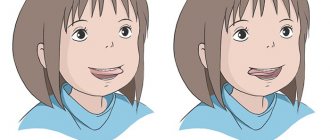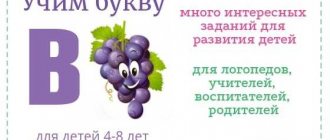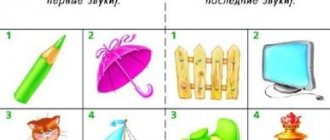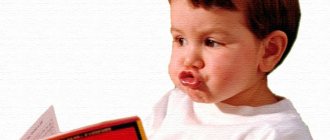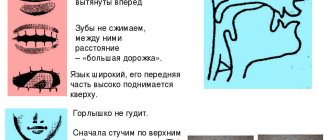Sound [a], letter A. Lesson summary for pre-school group
Topic: “Sound [a], letter A”
Program objectives:
Correctional and educational :
clarify the acoustic-articulatory characteristics of sound;
give the concept of a sentence, show that sentences consist of words, introduce the scheme of a sentence, teach how to determine the number of words in a sentence; Correctional and developmental :
develop phonemic processes, the ability to highlight a vowel sound at the beginning of a word, select words with a given sound, consolidate the ability to compose small sentences;
Correctional and educational :
develop the ability to listen to each other, the skill of self-control of speech.
Equipment:
individual mirrors, pencil cases with handouts, sentence diagrams (strips), plot pictures.
Progress of the lesson:
- Organizing time.
D/i “Recognize the sound by silent articulation”
- Making a riddle.
It is big, like a football, If it is ripe, everyone is happy. It tastes so good, And its name is... (watermelon). — What is the first sound heard in the word “watermelon”? - When we pronounce the sound [a], the mouth is wide open, the air comes out of the mouth freely, there is no obstacle in the mouth (no lips, no teeth, no tongue, nothing prevents the air from freely coming out of the mouth). - Vowel or consonant sound [a]? Why did you decide that the sound [a] is a vowel? (there is no obstruction in the mouth). Which costume wears the sound [a]? (red). What does the sound [a] like to “do”? (sing, sing your song, recite). Sing the sound [a] (quiet - loud - intermittently, high - low). - The sound [a] lives in the apartment - the letter “A”. We see, read and write letters. And we hear and pronounce the sound. 3. D/i “Who is attentive?” - clap your hands when you hear the sound [a]. a) in the sound series: o, u, a, i, a, s, a, e, a, e, a. b) in syllables: am, um, ka, py, ta, pa, ak, os, sa. a) in words: alphabet, cat, hand, legs, windows, poppy, Masha, blue, bus... 4. A speech therapist’s story. One day, grandfather brought Alyosha fruit and a large sugar watermelon. Alyosha decided to treat his friends to watermelon. Guess what the names of Alyosha's friends were, if their names began with the sound [a] (Anton, Artem, Andrey, Anya, Alena, Arseny, Alina, Albina, Alisa, Alexander, Alla, Angela, Anfisa, Arkady...)? What fruit did Alyosha treat his friends to if the first sound [a] was heard in the name of the fruit (quince, pineapple, cherry plum, orange)? 5. Sound analysis: ak, am, ka, ma. 6. Physical exercise. Finger gymnastics. 7. – Guys, do you understand what I’m going to say now: “Alyosha, draw a bus”? It was incomprehensible, because my words were not friendly, there was no agreement between them. Listen, is it clear what I’m going to say now: “Alyosha is drawing a bus”? Who did you hear about? What is Alyosha doing? What is he drawing? The words in the sentence are “friends”; they are related to each other in meaning. This sentence can be laid out in strips. What's the first word? (second, third) 8. Children make sentences based on pictures, lay out diagrams (give a name to the child shown in the picture, starting with the sound [a]). 9. Summary. - What sound did we meet? And at the end the game is for you. In it we will now test your ability to: Distinguish between words and sentences.
- If I say a word, you will stretch your arms forward and say “word.” If it’s a proposal, put your hands to the sides and say “proposal.”
"Sound and letter A." Literacy activity
Program content:
- introduce the sound and letter A;
- develop articulatory and finger motor skills. Develop phonemic processes: distinguishing onomatopoeia and everyday noises, identifying the isolated sound A among others, identifying the sound at the beginning of a word. Develop constructive praxis, visual perception;
- cultivate cognitive interest through playful moments.
EQUIPMENT: laptop, computer game “Learning to speak correctly” from the “Soon to school” series; symbols of vowel sounds, photo album; surprise picture; individual mirrors; subject pictures for sound A; subject pictures whose names begin with the sound A and other sounds; the letter a; "Magic" squares according to the number of children.
LITERARY SERIES: poem about the letter A.
PROGRESS OF THE CLASS
I. Organizational moment.
— Guys, which of you likes to play computer games? Today I brought you an interesting game, only very attentive guys can play it. Which one of you is attentive?
(Children sit together with a speech therapist in front of a computer. A game to differentiate onomatopoeia, household noises and sounds of nature. Children take turns playing the game).
II. Report the topic of the lesson.
- Guys, now you listened carefully and guessed the sounds that can be heard on the street, the sounds that objects and animals make. But now a sound will come to visit us, which cannot be produced by objects and animals; only a person can pronounce it. Meet us, guys, the sound A has come to us. He loves to sing and at the same time opens his mouth very wide.
(The sound symbol A is set).
- Guys, sound A really wants to meet you and make friends. He didn’t come to us empty-handed, but brought a surprise with him - a picture, but he doesn’t want to just give it away, but wants to play with you. Sound A has prepared interesting tasks for you and for each completed task it will give you one part of the picture. And when you complete all the tasks, you will be able to collect the picture.
III. Introducing the sound symbol A.
— Friends usually show each other albums with photographs. So sound A brought us his album, let's look at it: here are photographs of sound A and his friends. Let's find photos of sound A.
(Joint viewing of the album with children)
- Well done, you found all the photographs of sound A. For this you get one part of the surprise - pictures.
IV. Conjugate gymnastics.
- And now the sound A wants to teach us to sing just like it, for this we need to train the niches of the lips, and our fingers will help us. We will do the exercise “Chicks in the Nest”.
a) “Nest”;
b) “Chicks.”
V. Characteristics of sound A in front of a mirror.
(Each child has an individual mirror).
- Now we will also learn to open our mouth wide in the same way as the sound A: the mouth is wide open, looks like a circle, the tongue calmly lies below the lower teeth, the song stretches on, does not meet any obstacles, a vowel.
- Well done, guys, it’s great that you can sing like the sound A. For this you get another part of the picture.
VI. Onomatopoeia.
- Sound A is very important, we can’t live without it: - What does the doctor ask you to say when he looks at the neck? (Ahhh) - How does a mother rock her baby? (Ahhh)
VII. Development of phonemic hearing.
a) distinguishing a sound from a number of others: “Let’s clap for sound A”:
- And now sound A wants to sing for us, and when we hear his song, we will clap for him, and if you hear other sounds, then there is no need to clap.
- Well done, for being such attentive listeners, sound A gives you another part of the picture.
b) isolating a sound from the beginning of a word: “Let’s give postcards to sound A”:
- And now we will make a gift for sound A. We will give him cards. You need to select only those with objects whose names begin with the sound A.
- Sound A really liked your postcards, for this he gives you another part of the picture.
VIII. Introducing the letter A.
a) analysis of the appearance of the letter:
- Where did the sound A come to us from? He has a house, he lives there, and this house is called the letter A. Here it is.
(The letter A is placed on the board. Children express their opinions on what the house near the sound A is like. Then the adult introduces everyone to the poem):
“A” hut, look,
And a bench inside.
b) constructing the letter A from the “Magic Square”:
- Let's build houses for the sound A - Letters A. We will build the same letter A from triangles and stripes as on the postcard.
- You made wonderful letters A. Here is another part of the picture.
c) recognizing the letter A in a plot picture:
- Sound A really liked playing with you, but it’s time for him to return home, and here’s his last task: we need to take our new friend home - find all his houses - the letters A in this picture.
(Children get up from their seats, approach the story picture and each finds one letter).
- Well done, guys, you completed all the tasks and you have all the parts of the picture - a surprise, let's collect it. Let's thank our guest and see him off.
IX. Summary of the lesson.
(The summary of the lesson is based on the collected picture, which depicts the letter a and a stork)
— What sound came to visit us today?
— What is the name of the house of sound A?
- What funny rhyme did we learn about the letter A today?
- Why did our new friend draw a stork in this picture?
Author: Andronova Natalya Andreevna teacher-speech therapist, MBDOU compensatory kindergarten No. 100 “Bereginya” Russia, Irkutsk region, Irkutsk.
The article is published in the author's edition.


